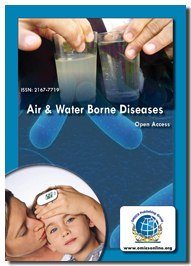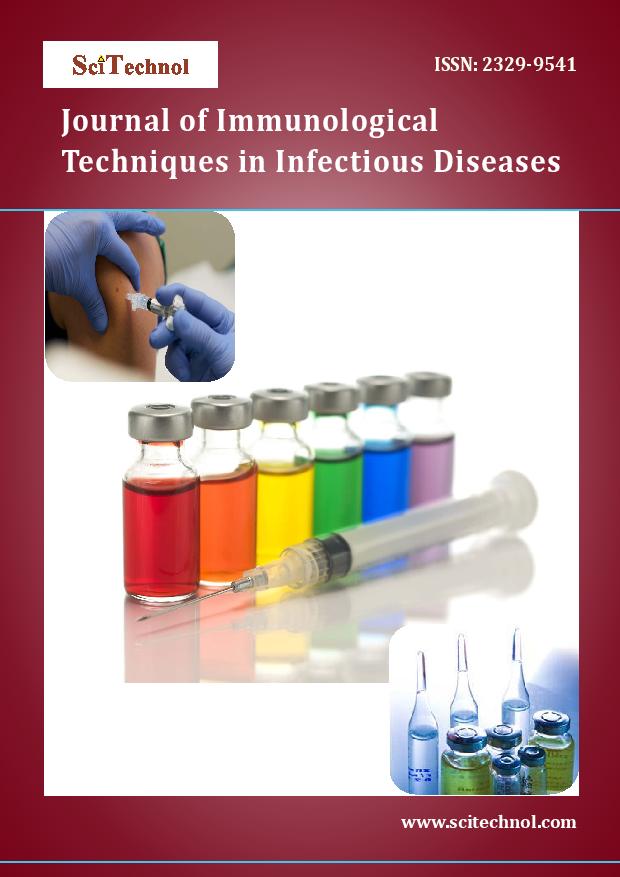Theme: Fighting Infectious Diseases with Novel and Innovative Therapeutic Techniques
Infectious Diseases 2016
Track 01: Infectious Diseases
The diseases caused by germs and which may infect any part of the body are called infectious diseases. They can be spread by any means where there is a germ. They are caused by pathogenic microorganisms such as bacteria, virus, parasites and fungi. Germs can be spread by direct or indirect contact. Vaccination, maintenance of proper hygiene and medicines help in the prevention of infection.
Related Conferences
5th World Congress on Infection Prevention and Control, Oct 26-27, 2017 Italy, 2nd Annual Conference on Rare Diseases and Orphan Drugs, Oct 30-Nov 01, 2017 USA, 3rd International Conference on Influenza and Zoonotic Diseases, Aug 21-22, 2017 UK, 4th International Conference on Chronic Obstructive Pulmonary Disease (COPD), May 29-31, 2017 Japan, 3rd International Conference on Flu, Oct 30-Nov 01, 2017 USA, Keystone Symposia: New developments in our basic understanding of tuberculosis, Jan 14-18, 2017 Canada, 35th UC Davis Annual infectious diseases conference, Feb 03-04, 2017 USA, 24th Conference on retroviruses and opportunistic infections, Feb 13-16, 2017 USA, Keystone Symposia Malaria: From innovation to eradication, Feb 19-23, 2017 Uganda, Australasian society for infectious diseases annual scientific meeting, Mar 29-Apr 01, 2017 Australia.
Track 02: Causes and Symptoms of Infectious Diseases
Infectious diseases can be caused by bacteria, virus, fungi and parasites through direct contact, indirect contact, insect bites and food contamination. Each infectious disease has its own specific signs and symptoms. General signs and symptoms common to a number of infectious diseases include fever, diarrhoea, fatigue and muscle aches.
Related Conferences
5th World Congress on Infection Prevention and Control, Oct 26-27, 2017 Italy, 2nd Annual Conference on Rare Diseases and Orphan Drugs, Oct 30-Nov 01, 2017 USA, 3rd International Conference on Influenza and Zoonotic Diseases, Aug 21-22, 2017 UK, 4th International Conference on Chronic Obstructive Pulmonary Disease (COPD), May 29-31, 2017 Japan, 3rd International Conference on Flu, Oct 30-Nov 01, 2017 USA, Keystone Symposia: New developments in our basic understanding of tuberculosis, Jan 14-18, 2017 Canada, 35th UC Davis Annual infectious diseases conference, Feb 03-04, 2017 USA, 24th Conference on retroviruses and opportunistic infections, Feb 13-16, 2017 USA, Keystone Symposia Malaria: From innovation to eradication, Feb 19-23, 2017 Uganda, Australasian society for infectious diseases annual scientific meeting, Mar 29-Apr 01, 2017 Australia.
Track 03: Global Trends in Emerging Infectious Diseases
An Infectious disease whose occurrence has increased in the past years or threatens to increase is termed as emerging. These diseases include new infections, previously unrecognized infections and old infections reappearing due to antimicrobial resistance, public health issues and unhygienic conditions.
Related Conferences
5th World Congress on Infection Prevention and Control, Oct 26-27, 2017 Italy, 2nd Annual Conference on Rare Diseases and Orphan Drugs, Oct 30-Nov 01, 2017 USA, 3rd International Conference on Influenza and Zoonotic Diseases, Aug 21-22, 2017 UK, 4th International Conference on Chronic Obstructive Pulmonary Disease (COPD), May 29-31, 2017 Japan, 3rd International Conference on Flu, Oct 30-Nov 01, 2017 USA, Keystone Symposia: New developments in our basic understanding of tuberculosis, Jan 14-18, 2017 Canada, 35th UC Davis Annual infectious diseases conference, Feb 03-04, 2017 USA, 24th Conference on retroviruses and opportunistic infections, Feb 13-16, 2017 USA, Keystone Symposia Malaria: From innovation to eradication, Feb 19-23, 2017 Uganda, Australasian society for infectious diseases annual scientific meeting, Mar 29-Apr 01, 2017 Australia.
Track 04: Clinical Studies and Case Reports
Clinical studies helps in inventing new treatment methods which helps in providing effective treatment. Case reports on infectious diseases include research, biology, epidemiology and clinical aspects of all infection related diseases.
Related Conferences
5th World Congress on Infection Prevention and Control, Oct 26-27, 2017 Italy, 2nd Annual Conference on Rare Diseases and Orphan Drugs, Oct 30-Nov 01, 2017 USA, 3rd International Conference on Influenza and Zoonotic Diseases, Aug 21-22, 2017 UK, 4th International Conference on Chronic Obstructive Pulmonary Disease (COPD), May 29-31, 2017 Japan, 3rd International Conference on Flu, Oct 30-Nov 01, 2017 USA, Keystone Symposia: New developments in our basic understanding of tuberculosis, Jan 14-18, 2017 Canada, 35th UC Davis Annual infectious diseases conference, Feb 03-04, 2017 USA, 24th Conference on retroviruses and opportunistic infections, Feb 13-16, 2017 USA, Keystone Symposia Malaria: From innovation to eradication, Feb 19-23, 2017 Uganda, Australasian society for infectious diseases annual scientific meeting, Mar 29-Apr 01, 2017 Australia.
Track 05: Microbial Pathogenesis and Virulence
Microbial pathogenesis is the study of the molecular mechanisms used by microorganisms to cause disease in humans and animals. By understanding how pathogens cause disease helps in the development of new therapeutic approaches. Virulence is the measure of the pathogenicity of an organism. The degree of virulence is related directly to the ability of the organism to cause infection despite host resistance mechanisms, it is affected by numerous variables such as the number of infecting bacteria, route of entry into the body, specific and nonspecific host defence mechanisms and virulence factors of the bacterium.
Related Conferences
5th World Congress on Infection Prevention and Control, Oct 26-27, 2017 Italy, 2nd Annual Conference on Rare Diseases and Orphan Drugs, Oct 30-Nov 01, 2017 USA, 3rd International Conference on Influenza and Zoonotic Diseases, Aug 21-22, 2017 UK, 4th International Conference on Chronic Obstructive Pulmonary Disease (COPD), May 29-31, 2017 Japan, 3rd International Conference on Flu, Oct 30-Nov 01, 2017 USA, Keystone Symposia: New developments in our basic understanding of tuberculosis, Jan 14-18, 2017 Canada, 35th UC Davis Annual infectious diseases conference, Feb 03-04, 2017 USA, 24th Conference on retroviruses and opportunistic infections, Feb 13-16, 2017 USA, Keystone Symposia Malaria: From innovation to eradication, Feb 19-23, 2017 Uganda, Australasian society for infectious diseases annual scientific meeting, Mar 29-Apr 01, 2017 Australia.
Track 06: Immunology of Infections
Immunology of infections means the battle between pathogens and the host immune defences. Immunology is the branch of science concerned with the various aspects related to immune system, innate and acquired immunity. Immunology also deals with laboratory techniques involving the interaction of antigens with specific antibodies.
Related Conferences
5th World Congress on Infection Prevention and Control, Oct 26-27, 2017 Italy, 2nd Annual Conference on Rare Diseases and Orphan Drugs, Oct 30-Nov 01, 2017 USA, 3rd International Conference on Influenza and Zoonotic Diseases, Aug 21-22, 2017 UK, 4th International Conference on Chronic Obstructive Pulmonary Disease (COPD), May 29-31, 2017 Japan, 3rd International Conference on Flu, Oct 30-Nov 01, 2017 USA, Keystone Symposia: New developments in our basic understanding of tuberculosis, Jan 14-18, 2017 Canada, 35th UC Davis Annual infectious diseases conference, Feb 03-04, 2017 USA, 24th Conference on retroviruses and opportunistic infections, Feb 13-16, 2017 USA, Keystone Symposia Malaria: From innovation to eradication, Feb 19-23, 2017 Uganda, Australasian society for infectious diseases annual scientific meeting, Mar 29-Apr 01, 2017 Australia.
Track 07: Mechanism of Resistance
Mechanism of resistance towards antimicrobials by microorganisms includes the following mechanisms of enzymatic destruction, enzymatic modification, altered target and decreased uptake. Mechanism of resistance is due to the inactivation or modification of antibiotics, an alteration in the target site of the antibiotic that reduces its binding capacity, the modification of metabolic pathways to circumvent the antibiotic effect and the reduced intracellular antibiotic accumulation by decreasing permeability and/ or increasing active efflux of the antibiotic.
Related Conferences
5th World Congress on Infection Prevention and Control, Oct 26-27, 2017 Italy, 2nd Annual Conference on Rare Diseases and Orphan Drugs, Oct 30-Nov 01, 2017 USA, 3rd International Conference on Influenza and Zoonotic Diseases, Aug 21-22, 2017 UK, 4th International Conference on Chronic Obstructive Pulmonary Disease (COPD), May 29-31, 2017 Japan, 3rd International Conference on Flu, Oct 30-Nov 01, 2017 USA, Keystone Symposia: New developments in our basic understanding of tuberculosis, Jan 14-18, 2017 Canada, 35th UC Davis Annual infectious diseases conference, Feb 03-04, 2017 USA, 24th Conference on retroviruses and opportunistic infections, Feb 13-16, 2017 USA, Keystone Symposia Malaria: From innovation to eradication, Feb 19-23, 2017 Uganda, Australasian society for infectious diseases annual scientific meeting, Mar 29-Apr 01, 2017 Australia.
Track 08: Antimicrobial/ Antibiotic/ Antibacterial Resistance
Antimicrobial/ antibiotic/ antibacterial resistance is the ability of microorganisms to resist the effects of drugs that means diseases causing germs do not get killed and their growth is not stopped. Antibiotic resistant infections are of greater risk which cannot be avoided completely. Infections with resistant organisms are difficult to treat requiring costly and sometimes toxic alternatives.
Related Conferences
5th World Congress on Infection Prevention and Control, Oct 26-27, 2017 Italy, 2nd Annual Conference on Rare Diseases and Orphan Drugs, Oct 30-Nov 01, 2017 USA, 3rd International Conference on Influenza and Zoonotic Diseases, Aug 21-22, 2017 UK, 4th International Conference on Chronic Obstructive Pulmonary Disease (COPD), May 29-31, 2017 Japan, 3rd International Conference on Flu, Oct 30-Nov 01, 2017 USA, Keystone Symposia: New developments in our basic understanding of tuberculosis, Jan 14-18, 2017 Canada, 35th UC Davis Annual infectious diseases conference, Feb 03-04, 2017 USA, 24th Conference on retroviruses and opportunistic infections, Feb 13-16, 2017 USA, Keystone Symposia Malaria: From innovation to eradication, Feb 19-23, 2017 Uganda, Australasian society for infectious diseases annual scientific meeting, Mar 29-Apr 01, 2017 Australia.
Track 09: Antimicrobial/ Antibiotic/ Antibacterial Stewardship
Antimicrobial/ antibiotic/ antibacterial stewardship promotes the appropriate use of antimicrobials which improves patient outcomes reduces microbial resistance and decreases the spread of infections caused by multidrug resistant organisms.
Related Conferences
5th World Congress on Infection Prevention and Control, Oct 26-27, 2017 Italy, 2nd Annual Conference on Rare Diseases and Orphan Drugs, Oct 30-Nov 01, 2017 USA, 3rd International Conference on Influenza and Zoonotic Diseases, Aug 21-22, 2017 UK, 4th International Conference on Chronic Obstructive Pulmonary Disease (COPD), May 29-31, 2017 Japan, 3rd International Conference on Flu, Oct 30-Nov 01, 2017 USA, Keystone Symposia: New developments in our basic understanding of tuberculosis, Jan 14-18, 2017 Canada, 35th UC Davis Annual infectious diseases conference, Feb 03-04, 2017 USA, 24th Conference on retroviruses and opportunistic infections, Feb 13-16, 2017 USA, Keystone Symposia Malaria: From innovation to eradication, Feb 19-23, 2017 Uganda, Australasian society for infectious diseases annual scientific meeting, Mar 29-Apr 01, 2017 Australia.
Track 10: Epidemiology of Emerging and Re-Emerging Infectious Diseases
Epidemiology studies the patterns, causes and effects of health and disease conditions. It is the cornerstone of public health and informs policy decisions and evidence based practice by identifying risk factors for disease and targets for preventive healthcare. Epidemiologists help with study design, data collection, statistical analysis of data, interpretation and dissemination. Epidemiology helped to develop methodology used in clinical research, public health studies and to a lesser extent basic research in the biological sciences.
Related Conferences
5th World Congress on Infection Prevention and Control, Oct 26-27, 2017 Italy, 2nd Annual Conference on Rare Diseases and Orphan Drugs, Oct 30-Nov 01, 2017 USA, 3rd International Conference on Influenza and Zoonotic Diseases, Aug 21-22, 2017 UK, 4th International Conference on Chronic Obstructive Pulmonary Disease (COPD), May 29-31, 2017 Japan, 3rd International Conference on Flu, Oct 30-Nov 01, 2017 USA, Keystone Symposia: New developments in our basic understanding of tuberculosis, Jan 14-18, 2017 Canada, 35th UC Davis Annual infectious diseases conference, Feb 03-04, 2017 USA, 24th Conference on retroviruses and opportunistic infections, Feb 13-16, 2017 USA, Keystone Symposia Malaria: From innovation to eradication, Feb 19-23, 2017 Uganda, Australasian society for infectious diseases annual scientific meeting, Mar 29-Apr 01, 2017 Australia.
Track 11: Diagnosis of Infectious Diseases
Medical diagnosis is the process of determining which disease or condition explains a person's symptoms and signs. Laboratory tests may identify organisms directly (e.g., visually, using a microscope growing the organism in culture) or indirectly (e.g., identifying antibodies to the organism). General types of tests include microscopy, culture and immunologic tests (agglutination tests such as latex agglutination, enzyme immunoassays, western blot, precipitation tests and complement fixation tests) and nucleic acid/ non nucleic acid based identification methods. Sub types of diagnoses include clinical, laboratory, radiology, principal and admitting diagnosis. Advanced methods have been implemented to diagnose the infection in any part of the body. Examples include biomarkers/ elisa test/ chest x ray/ skin biopsy/ tympanometry and tympanocentesis.
Related Conferences
5th World Congress on Infection Prevention and Control, Oct 26-27, 2017 Italy, 2nd Annual Conference on Rare Diseases and Orphan Drugs, Oct 30-Nov 01, 2017 USA, 3rd International Conference on Influenza and Zoonotic Diseases, Aug 21-22, 2017 UK, 4th International Conference on Chronic Obstructive Pulmonary Disease (COPD), May 29-31, 2017 Japan, 3rd International Conference on Flu, Oct 30-Nov 01, 2017 USA, Keystone Symposia: New developments in our basic understanding of tuberculosis, Jan 14-18, 2017 Canada, 35th UC Davis Annual infectious diseases conference, Feb 03-04, 2017 USA, 24th Conference on retroviruses and opportunistic infections, Feb 13-16, 2017 USA, Keystone Symposia Malaria: From innovation to eradication, Feb 19-23, 2017 Uganda, Australasian society for infectious diseases annual scientific meeting, Mar 29-Apr 01, 2017 Australia.
Track 12: Treatment for Infectious Diseases
Treatment of viral infections such as HIV involves patient care and moral support including antiretroviral therapy. Bacterial infections can be treated by administering antibiotics to the patients. Yeast infections can be primarily treated by sterilisation methods. Parasitic infections can be treated by antiparasitic drugs. Diseases such as cancer can be treated by chemotherapy. Recent techniques have proved that there is no disease that cannot be treated.
Related Conferences
5th World Congress on Infection Prevention and Control, Oct 26-27, 2017 Italy, 2nd Annual Conference on Rare Diseases and Orphan Drugs, Oct 30-Nov 01, 2017 USA, 3rd International Conference on Influenza and Zoonotic Diseases, Aug 21-22, 2017 UK, 4th International Conference on Chronic Obstructive Pulmonary Disease (COPD), May 29-31, 2017 Japan, 3rd International Conference on Flu, Oct 30-Nov 01, 2017 USA, Keystone Symposia: New developments in our basic understanding of tuberculosis, Jan 14-18, 2017 Canada, 35th UC Davis Annual infectious diseases conference, Feb 03-04, 2017 USA, 24th Conference on retroviruses and opportunistic infections, Feb 13-16, 2017 USA, Keystone Symposia Malaria: From innovation to eradication, Feb 19-23, 2017 Uganda, Australasian society for infectious diseases annual scientific meeting, Mar 29-Apr 01, 2017 Australia.
Track 13: Infectious Diseases Prevention, Control and Cure
Infectious diseases prevention and control is helpful to prevent the transmission of infectious diseases. Aseptic technique is normally applied to prevent the infections caused by different means. Sterilization is another process of killing microorganisms by the application of heat. Disinfection is the process of killing harmful microorganisms. Some infectious diseases can be prevented by avoiding direct contact with the contagious person. Infections can also be controlled and prevented by creating public awareness on various infectious diseases and their outbreaks. Infections can be cured by various antimicrobials.
Related Conferences
5th World Congress on Infection Prevention and Control, Oct 26-27, 2017 Italy, 2nd Annual Conference on Rare Diseases and Orphan Drugs, Oct 30-Nov 01, 2017 USA, 3rd International Conference on Influenza and Zoonotic Diseases, Aug 21-22, 2017 UK, 4th International Conference on Chronic Obstructive Pulmonary Disease (COPD), May 29-31, 2017 Japan, 3rd International Conference on Flu, Oct 30-Nov 01, 2017 USA, Keystone Symposia: New developments in our basic understanding of tuberculosis, Jan 14-18, 2017 Canada, 35th UC Davis Annual infectious diseases conference, Feb 03-04, 2017 USA, 24th Conference on retroviruses and opportunistic infections, Feb 13-16, 2017 USA, Keystone Symposia Malaria: From innovation to eradication, Feb 19-23, 2017 Uganda, Australasian society for infectious diseases annual scientific meeting, Mar 29-Apr 01, 2017 Australia.
Track 14: Infectious Diseases Vaccines
Infectious diseases vaccines are the vaccines which prevent the infectious diseases and infectious diseases like diphtheria, haemophilus influenzae serotype b infection, hepatitis b, measles, meningitis, mumps, pertussis, poliomyelitis, rubella, tetanus, tuberculosis and yellow fever are preventable through vaccines.
Related Conferences
5th World Congress on Infection Prevention and Control, Oct 26-27, 2017 Italy, 2nd Annual Conference on Rare Diseases and Orphan Drugs, Oct 30-Nov 01, 2017 USA, 3rd International Conference on Influenza and Zoonotic Diseases, Aug 21-22, 2017 UK, 4th International Conference on Chronic Obstructive Pulmonary Disease (COPD), May 29-31, 2017 Japan, 3rd International Conference on Flu, Oct 30-Nov 01, 2017 USA, Keystone Symposia: New developments in our basic understanding of tuberculosis, Jan 14-18, 2017 Canada, 35th UC Davis Annual infectious diseases conference, Feb 03-04, 2017 USA, 24th Conference on retroviruses and opportunistic infections, Feb 13-16, 2017 USA, Keystone Symposia Malaria: From innovation to eradication, Feb 19-23, 2017 Uganda, Australasian society for infectious diseases annual scientific meeting, Mar 29-Apr 01, 2017 Australia.
Track 15: Sexually Transmitted Diseases/ Sexually Transmitted Infections
Sexually transmitted diseases/ sexually transmitted infections are the infections which are transmitted through sexual contact with an infected individual and also transmitted during vaginal or other types of sexual intercourse including oral and anal sex.
Related Conferences
5th World Congress on Infection Prevention and Control, Oct 26-27, 2017 Italy, 2nd Annual Conference on Rare Diseases and Orphan Drugs, Oct 30-Nov 01, 2017 USA, 3rd International Conference on Influenza and Zoonotic Diseases, Aug 21-22, 2017 UK, 4th International Conference on Chronic Obstructive Pulmonary Disease (COPD), May 29-31, 2017 Japan, 3rd International Conference on Flu, Oct 30-Nov 01, 2017 USA, Keystone Symposia: New developments in our basic understanding of tuberculosis, Jan 14-18, 2017 Canada, 35th UC Davis Annual infectious diseases conference, Feb 03-04, 2017 USA, 24th Conference on retroviruses and opportunistic infections, Feb 13-16, 2017 USA, Keystone Symposia Malaria: From innovation to eradication, Feb 19-23, 2017 Uganda, Australasian society for infectious diseases annual scientific meeting, Mar 29-Apr 01, 2017 Australia.
Track 16: Pediatric Infectious Diseases/ Childhood Infectious Diseases
Pediatric infectious diseases/ childhood infectious diseases are the infectious diseases which are caused in children of different age groups. Pediatric infectious diseases specialist’s takes care of the infections occurring in children and the treatment methods vary for children from adults.
Related Conferences
5th World Congress on Infection Prevention and Control, Oct 26-27, 2017 Italy, 2nd Annual Conference on Rare Diseases and Orphan Drugs, Oct 30-Nov 01, 2017 USA, 3rd International Conference on Influenza and Zoonotic Diseases, Aug 21-22, 2017 UK, 4th International Conference on Chronic Obstructive Pulmonary Disease (COPD), May 29-31, 2017 Japan, 3rd International Conference on Flu, Oct 30-Nov 01, 2017 USA, Keystone Symposia: New developments in our basic understanding of tuberculosis, Jan 14-18, 2017 Canada, 35th UC Davis Annual infectious diseases conference, Feb 03-04, 2017 USA, 24th Conference on retroviruses and opportunistic infections, Feb 13-16, 2017 USA, Keystone Symposia Malaria: From innovation to eradication, Feb 19-23, 2017 Uganda, Australasian society for infectious diseases annual scientific meeting, Mar 29-Apr 01, 2017 Australia.
Track 17: Neuro Infectious Diseases
Neuro infectious diseases are the infectious diseases which are observed in the nervous system. Viral and immune mediated disorders of the nervous system are among the most challenging neurological disorders. The most common neuro immune disorder is multiple sclerosis and hiv is the most common viral infection of the nervous system.
Related Conferences
5th World Congress on Infection Prevention and Control, Oct 26-27, 2017 Italy, 2nd Annual Conference on Rare Diseases and Orphan Drugs, Oct 30-Nov 01, 2017 USA, 3rd International Conference on Influenza and Zoonotic Diseases, Aug 21-22, 2017 UK, 4th International Conference on Chronic Obstructive Pulmonary Disease (COPD), May 29-31, 2017 Japan, 3rd International Conference on Flu, Oct 30-Nov 01, 2017 USA, Keystone Symposia: New developments in our basic understanding of tuberculosis, Jan 14-18, 2017 Canada, 35th UC Davis Annual infectious diseases conference, Feb 03-04, 2017 USA, 24th Conference on retroviruses and opportunistic infections, Feb 13-16, 2017 USA, Keystone Symposia Malaria: From innovation to eradication, Feb 19-23, 2017 Uganda, Australasian society for infectious diseases annual scientific meeting, Mar 29-Apr 01, 2017 Australia.
Track 18: Noscomial Infections/ Hospital Acquired Infections/ Health Care Associated Infections
Nosocomial infections/ hospital acquired infections/ health care associated infections are the infections that are contracted from the environment or staff of a healthcare facility and they spread in the hospital environment, nursing home environment, rehabilitation facility and clinic or other clinical settings.
Related Conferences
5th World Congress on Infection Prevention and Control, Oct 26-27, 2017 Italy, 2nd Annual Conference on Rare Diseases and Orphan Drugs, Oct 30-Nov 01, 2017 USA, 3rd International Conference on Influenza and Zoonotic Diseases, Aug 21-22, 2017 UK, 4th International Conference on Chronic Obstructive Pulmonary Disease (COPD), May 29-31, 2017 Japan, 3rd International Conference on Flu, Oct 30-Nov 01, 2017 USA, Keystone Symposia: New developments in our basic understanding of tuberculosis, Jan 14-18, 2017 Canada, 35th UC Davis Annual infectious diseases conference, Feb 03-04, 2017 USA, 24th Conference on retroviruses and opportunistic infections, Feb 13-16, 2017 USA, Keystone Symposia Malaria: From innovation to eradication, Feb 19-23, 2017 Uganda, Australasian society for infectious diseases annual scientific meeting, Mar 29-Apr 01, 2017 Australia.
Track 19: Blood Stream Infections/ Bacteraemia/ Septicaemia/ Blood poisoning
Blood stream infections/ bacteraemia/ septicaemia/ blood poisoning occurs when a bacterial infection elsewhere in the body such as in the lungs or skin which enters the blood stream. This is dangerous because the bacteria and their toxins can be carried through the blood stream to the entire body.
Related Conferences
5th World Congress on Infection Prevention and Control, Oct 26-27, 2017 Italy, 2nd Annual Conference on Rare Diseases and Orphan Drugs, Oct 30-Nov 01, 2017 USA, 3rd International Conference on Influenza and Zoonotic Diseases, Aug 21-22, 2017 UK, 4th International Conference on Chronic Obstructive Pulmonary Disease (COPD), May 29-31, 2017 Japan, 3rd International Conference on Flu, Oct 30-Nov 01, 2017 USA, Keystone Symposia: New developments in our basic understanding of tuberculosis, Jan 14-18, 2017 Canada, 35th UC Davis Annual infectious diseases conference, Feb 03-04, 2017 USA, 24th Conference on retroviruses and opportunistic infections, Feb 13-16, 2017 USA, Keystone Symposia Malaria: From innovation to eradication, Feb 19-23, 2017 Uganda, Australasian society for infectious diseases annual scientific meeting, Mar 29-Apr 01, 2017 Australia.
Track 20: Urinary Tract Infections
Urinary tract infections are the infections which are observed in any part of the urinary system (kidneys, ureters, bladder and urethra). Mostly infections are observed in the lower urinary tract (bladder and urethra). Women are at greater risk than men.
Related Conferences
5th World Congress on Infection Prevention and Control, Oct 26-27, 2017 Italy, 2nd Annual Conference on Rare Diseases and Orphan Drugs, Oct 30-Nov 01, 2017 USA, 3rd International Conference on Influenza and Zoonotic Diseases, Aug 21-22, 2017 UK, 4th International Conference on Chronic Obstructive Pulmonary Disease (COPD), May 29-31, 2017 Japan, 3rd International Conference on Flu, Oct 30-Nov 01, 2017 USA, Keystone Symposia: New developments in our basic understanding of tuberculosis, Jan 14-18, 2017 Canada, 35th UC Davis Annual infectious diseases conference, Feb 03-04, 2017 USA, 24th Conference on retroviruses and opportunistic infections, Feb 13-16, 2017 USA, Keystone Symposia Malaria: From innovation to eradication, Feb 19-23, 2017 Uganda, Australasian society for infectious diseases annual scientific meeting, Mar 29-Apr 01, 2017 Australia.
Track 21: Surgical Site Infections
Surgical site infections are the infections which may occur within 30 days after the operation and are observed in the parts of skin and subcutaneous tissue of the incision.
Related Conferences
5th World Congress on Infection Prevention and Control, Oct 26-27, 2017 Italy, 2nd Annual Conference on Rare Diseases and Orphan Drugs, Oct 30-Nov 01, 2017 USA, 3rd International Conference on Influenza and Zoonotic Diseases, Aug 21-22, 2017 UK, 4th International Conference on Chronic Obstructive Pulmonary Disease (COPD), May 29-31, 2017 Japan, 3rd International Conference on Flu, Oct 30-Nov 01, 2017 USA, Keystone Symposia: New developments in our basic understanding of tuberculosis, Jan 14-18, 2017 Canada, 35th UC Davis Annual infectious diseases conference, Feb 03-04, 2017 USA, 24th Conference on retroviruses and opportunistic infections, Feb 13-16, 2017 USA, Keystone Symposia Malaria: From innovation to eradication, Feb 19-23, 2017 Uganda, Australasian society for infectious diseases annual scientific meeting, Mar 29-Apr 01, 2017 Australia.
Track 22: Ebola and Current Research
Ebola virus disease is caused by virus transmitted through body fluids and through air. It occurs rarely but it is very deadly which results in death and outbreak. Ebola virus disease symptoms are very severe which appears in 2-3 days. Ebola primary symptoms include fever, sore throat, muscular pain and headaches then followed by vomiting, diarrhea, rash, decreased function of the liver and kidneys then loss of blood internally and externally finally leading to low blood pressure and fluid loss resulting in death.
Related Conferences
5th World Congress on Infection Prevention and Control, Oct 26-27, 2017 Italy, 2nd Annual Conference on Rare Diseases and Orphan Drugs, Oct 30-Nov 01, 2017 USA, 3rd International Conference on Influenza and Zoonotic Diseases, Aug 21-22, 2017 UK, 4th International Conference on Chronic Obstructive Pulmonary Disease (COPD), May 29-31, 2017 Japan, 3rd International Conference on Flu, Oct 30-Nov 01, 2017 USA, Keystone Symposia: New developments in our basic understanding of tuberculosis, Jan 14-18, 2017 Canada, 35th UC Davis Annual infectious diseases conference, Feb 03-04, 2017 USA, 24th Conference on retroviruses and opportunistic infections, Feb 13-16, 2017 USA, Keystone Symposia Malaria: From innovation to eradication, Feb 19-23, 2017 Uganda, Australasian society for infectious diseases annual scientific meeting, Mar 29-Apr 01, 2017 Australia.
Track 23: Tuberculosis
Tuberculosis is a bacterial infection caused by a bacterium called mycobacterium tuberculosis which spread through the lymph nodes and blood stream to any organ in your body. It is most commonly found in the lungs which attack the lungs and it can also attack any part of the body such as the kidney, spine and brain.
Related Conferences
5th World Congress on Infection Prevention and Control, Oct 26-27, 2017 Italy, 2nd Annual Conference on Rare Diseases and Orphan Drugs, Oct 30-Nov 01, 2017 USA, 3rd International Conference on Influenza and Zoonotic Diseases, Aug 21-22, 2017 UK, 4th International Conference on Chronic Obstructive Pulmonary Disease (COPD), May 29-31, 2017 Japan, 3rd International Conference on Flu, Oct 30-Nov 01, 2017 USA, Keystone Symposia: New developments in our basic understanding of tuberculosis, Jan 14-18, 2017 Canada, 35th UC Davis Annual infectious diseases conference, Feb 03-04, 2017 USA, 24th Conference on retroviruses and opportunistic infections, Feb 13-16, 2017 USA, Keystone Symposia Malaria: From innovation to eradication, Feb 19-23, 2017 Uganda, Australasian society for infectious diseases annual scientific meeting, Mar 29-Apr 01, 2017 Australia.
Track 24: Hepatitis
Hepatitis is caused by the inflammation of the liver and characterized by the presence of inflammatory cells in the tissue of the organ. Hepatitis may occur with limited or no symptoms but often leads to jaundice, poor appetite and malaise. Hepatitis is acute when it lasts less than six months and chronic when it persists longer.
Related Conferences
5th World Congress on Infection Prevention and Control, Oct 26-27, 2017 Italy, 2nd Annual Conference on Rare Diseases and Orphan Drugs, Oct 30-Nov 01, 2017 USA, 3rd International Conference on Influenza and Zoonotic Diseases, Aug 21-22, 2017 UK, 4th International Conference on Chronic Obstructive Pulmonary Disease (COPD), May 29-31, 2017 Japan, 3rd International Conference on Flu, Oct 30-Nov 01, 2017 USA, Keystone Symposia: New developments in our basic understanding of tuberculosis, Jan 14-18, 2017 Canada, 35th UC Davis Annual infectious diseases conference, Feb 03-04, 2017 USA, 24th Conference on retroviruses and opportunistic infections, Feb 13-16, 2017 USA, Keystone Symposia Malaria: From innovation to eradication, Feb 19-23, 2017 Uganda, Australasian society for infectious diseases annual scientific meeting, Mar 29-Apr 01, 2017 Australia.
Track 25: Malaria
Malaria is a mosquito borne infectious disease affecting humans and other animals caused by parasitic protozoans (a group of single celled microorganisms) belonging to the plasmodium type. Malaria symptoms typically include fever, fatigue, vomiting and headaches which can be observed in 10-15 after being bitten by mosquito. In severe cases it can cause yellow skin, seizures, comaor and even death.
Related Conferences
5th World Congress on Infection Prevention and Control, Oct 26-27, 2017 Italy, 2nd Annual Conference on Rare Diseases and Orphan Drugs, Oct 30-Nov 01, 2017 USA, 3rd International Conference on Influenza and Zoonotic Diseases, Aug 21-22, 2017 UK, 4th International Conference on Chronic Obstructive Pulmonary Disease (COPD), May 29-31, 2017 Japan, 3rd International Conference on Flu, Oct 30-Nov 01, 2017 USA, Keystone Symposia: New developments in our basic understanding of tuberculosis, Jan 14-18, 2017 Canada, 35th UC Davis Annual infectious diseases conference, Feb 03-04, 2017 USA, 24th Conference on retroviruses and opportunistic infections, Feb 13-16, 2017 USA, Keystone Symposia Malaria: From innovation to eradication, Feb 19-23, 2017 Uganda, Australasian society for infectious diseases annual scientific meeting, Mar 29-Apr 01, 2017 Australia.
Track 26: Microbial Forensics and Molecular Basis of Bacteria
Microbial forensics and molecular basis of bacteria is defined as a scientific discipline which is used to analyse microorganism/ toxin release.
Related Conferences
5th World Congress on Infection Prevention and Control, Oct 26-27, 2017 Italy, 2nd Annual Conference on Rare Diseases and Orphan Drugs, Oct 30-Nov 01, 2017 USA, 3rd International Conference on Influenza and Zoonotic Diseases, Aug 21-22, 2017 UK, 4th International Conference on Chronic Obstructive Pulmonary Disease (COPD), May 29-31, 2017 Japan, 3rd International Conference on Flu, Oct 30-Nov 01, 2017 USA, Keystone Symposia: New developments in our basic understanding of tuberculosis, Jan 14-18, 2017 Canada, 35th UC Davis Annual infectious diseases conference, Feb 03-04, 2017 USA, 24th Conference on retroviruses and opportunistic infections, Feb 13-16, 2017 USA, Keystone Symposia Malaria: From innovation to eradication, Feb 19-23, 2017 Uganda, Australasian society for infectious diseases annual scientific meeting, Mar 29-Apr 01, 2017 Australia.
Track 27: Animal Infectious Diseases/ Zoonosis
Animal infectious diseases/ zoonosis are important threat to human health since the emergence of human diseases is dominated by zoonotic pathogens. Infectious diseases affect livestock and also wild animals focusing on characterizing the conditions for the pathogen spread and maintenance in the host population.
Related Conferences
5th World Congress on Infection Prevention and Control, Oct 26-27, 2017 Italy, 2nd Annual Conference on Rare Diseases and Orphan Drugs, Oct 30-Nov 01, 2017 USA, 3rd International Conference on Influenza and Zoonotic Diseases, Aug 21-22, 2017 UK, 4th International Conference on Chronic Obstructive Pulmonary Disease (COPD), May 29-31, 2017 Japan, 3rd International Conference on Flu, Oct 30-Nov 01, 2017 USA, Keystone Symposia: New developments in our basic understanding of tuberculosis, Jan 14-18, 2017 Canada, 35th UC Davis Annual infectious diseases conference, Feb 03-04, 2017 USA, 24th Conference on retroviruses and opportunistic infections, Feb 13-16, 2017 USA, Keystone Symposia Malaria: From innovation to eradication, Feb 19-23, 2017 Uganda, Australasian society for infectious diseases annual scientific meeting, Mar 29-Apr 01, 2017 Australia.
Track 28: Plant Disease Modelling and Parameter Estimation
Plant pathology is the study of diseases in plants caused by pathogens and environmental conditions. Organisms that cause infectious diseases include fungi, oomycetes, bacteria, viruses, viroids, virus like organisms, phytoplasmas, protozoa, nematodes and parasitic plants. Plant pathology also involves the study of pathogen identification, disease etiology, disease cycles, economic impact, plant disease epidemiology, plant disease resistance, how plant diseases affect humans and animals, pathosystem genetics and management of plant diseases.
Related Conferences
5th World Congress on Infection Prevention and Control, Oct 26-27, 2017 Italy, 2nd Annual Conference on Rare Diseases and Orphan Drugs, Oct 30-Nov 01, 2017 USA, 3rd International Conference on Influenza and Zoonotic Diseases, Aug 21-22, 2017 UK, 4th International Conference on Chronic Obstructive Pulmonary Disease (COPD), May 29-31, 2017 Japan, 3rd International Conference on Flu, Oct 30-Nov 01, 2017 USA, Keystone Symposia: New developments in our basic understanding of tuberculosis, Jan 14-18, 2017 Canada, 35th UC Davis Annual infectious diseases conference, Feb 03-04, 2017 USA, 24th Conference on retroviruses and opportunistic infections, Feb 13-16, 2017 USA, Keystone Symposia Malaria: From innovation to eradication, Feb 19-23, 2017 Uganda, Australasian society for infectious diseases annual scientific meeting, Mar 29-Apr 01, 2017 Australia.
Track 29: Global Market on Infectious Diseases
Global market report of infectious diseases is a complete study of current trends in the infectious diseases therapeutic and diagnostic market, industry growth drivers, advanced therapies and restraints. It provides market projections for the coming years. It includes analysis of recent developments in technology for infection diagnosis and treatment. Market reports also includes a review of micro and macro factors essential for the existing market players and new entrants along with detailed value chain analysis.
Related Conferences
5th World Congress on Infection Prevention and Control, Oct 26-27, 2017 Italy, 2nd Annual Conference on Rare Diseases and Orphan Drugs, Oct 30-Nov 01, 2017 USA, 3rd International Conference on Influenza and Zoonotic Diseases, Aug 21-22, 2017 UK, 4th International Conference on Chronic Obstructive Pulmonary Disease (COPD), May 29-31, 2017 Japan, 3rd International Conference on Flu, Oct 30-Nov 01, 2017 USA, Keystone Symposia: New developments in our basic understanding of tuberculosis, Jan 14-18, 2017 Canada, 35th UC Davis Annual infectious diseases conference, Feb 03-04, 2017 USA, 24th Conference on retroviruses and opportunistic infections, Feb 13-16, 2017 USA, Keystone Symposia Malaria: From innovation to eradication, Feb 19-23, 2017 Uganda, Australasian society for infectious diseases annual scientific meeting, Mar 29-Apr 01, 2017 Australia.
Track 30: Entrepreneurs Investment Meet
Entrepreneurs from infectious diseases field can exhibit their products and can give presentations on their products which should be helpful in research work, business development and marketing.
Related Conferences
5th World Congress on Infection Prevention and Control, Oct 26-27, 2017 Italy, 2nd Annual Conference on Rare Diseases and Orphan Drugs, Oct 30-Nov 01, 2017 USA, 3rd International Conference on Influenza and Zoonotic Diseases, Aug 21-22, 2017 UK, 4th International Conference on Chronic Obstructive Pulmonary Disease (COPD), May 29-31, 2017 Japan, 3rd International Conference on Flu, Oct 30-Nov 01, 2017 USA, Keystone Symposia: New developments in our basic understanding of tuberculosis, Jan 14-18, 2017 Canada, 35th UC Davis Annual infectious diseases conference, Feb 03-04, 2017 USA, 24th Conference on retroviruses and opportunistic infections, Feb 13-16, 2017 USA, Keystone Symposia Malaria: From innovation to eradication, Feb 19-23, 2017 Uganda, Australasian society for infectious diseases annual scientific meeting, Mar 29-Apr 01, 2017 Australia.
ConferenceSeries Ltd Conferences invites all the participants from all over the world to attend “2nd World Congress on Infectious Diseases” during August 24-26, 2016 in Philadelphia, Pennsylvania, USA which includes prompt keynote presentations, special sessions, workshops, symposiums, oral talks, poster presentations and exhibitions.
Infectious Diseases are disorders caused by organisms such as bacteria, viruses, fungi or parasites. Infectious diseases may be of water borne, food borne, vector borne, air borne in human beings as well as in plants and animals. Infectious diseases basically emphasize on the pathogenesis of the bacteria and their therapeutic measures, coalesce of branches of microbiology especially clinical and diagnostic microbiology which deals with the cure and prevention of the Infectious diseases. It represents an increasingly important cause of human morbidity and mortality throughout the world. Vaccine development is thus of great importance in terms of global health.
The conference attains significance when we look at the worldwide deaths due to Infectious Diseases like Tetanus (500,000), Measles (1 million), HIV/AIDS (1 million), Hepatitis B (1.1million), Malaria (2.1million), Diarrhoea (3.1 million), Tuberculosis (3.1 million) and Respiratory Infections (4.4 million).
Who should attend?
- Microbiologists
- Bacteriologists
- Virologists
- Parasitologists
- Mycologists
- Pathologists
- Pharmacists
- Epidemiologists
- Health Care Professionals
- Infectious Diseases Specialists
- Infection Prevention and Infection Control Specialists
Why to attend?
With members from around the world focused on learning about global trends on emerging infectious diseases and its advances in therapeutic and diagnostic market, this is your best opportunity to reach the largest assemblage of participants from the Infectious diseases community. This particular conference conduct presentations, distributes information, conducts meetings with current and potential scientists, make a splash with new drug developments, and receive name recognition at this 3 days event. World renowned speakers, the most recent therapeutic and diagnostic techniques, developments, and the Novel technologies and therapeutic measures for infectious diseases prevention and control are hallmarks of this conference.
Targeted Audience
- Directors, Board Members, Presidents, Vice Presidents, Deans and Head of the Departments
- Infectious Diseases Researchers, Scientists, Faculties, Students
- Infectious Diseases Associations and Societies
- Medical Colleges
- Pharmaceutical Companies and Industries
- Medical Devices Manufacturing Companies
- Drug Manufacturing Companies and Industries
- Laboratory Technicians and Diagnostic Companies
- Business Entrepreneurs and Industrialists
- Training Institutes
- Software Developing Companies
- Data Management Companies
For Scientific Sessions please go through the link: http://infection.omicsgroup.com/call-for-abstracts.php
For Abstract Submission please go through the link: http://infection.omicsgroup.com/abstract-submission.php
Infectious Diseases Therapeutic Market
The infectious diseases therapeutic market in US is estimated to grow at a rate of 3.37% between 2014- 2019. As per the records, 25% of deaths are mainly due to infectious diseases globally. Current market trend shows that North America has the more global market for infectious diseases therapeutics due to increasing incidence of infectious diseases and due to rise in aging population. Followed by North America highest global market is expected in Asia then followed by the Europe in the global infectious diseases therapeutics market. In Asia-Pacific region, China and India are expected to be the fastest growing infectious diseases therapeutics markets. The main reasons behind the highest global market of infectious diseases therapeutics market in the above countries is mainly due to large number of patients and due to increase in government funding. Some of the major companies playing a key role in the global infectious diseases therapeutics market are Merck & Co., Pfizer, Johnson & Johnson, F. Hoffmann-La Roche, GlaxoSmithKline Pharmaceutical, Inc., Auritec Pharmaceuticals, Novartis, Achillion Pharmaceuticals, Isis Pharmaceuticals and Gilead Sciences.
Infectious Diseases Diagnostics Market
Market for infectious disease molecular diagnostics tests includes hospitals, blood banks, reference laboratories. North America has the highest global market for molecular diagnostics tests followed by Europe due to the market availability of the tests and high occurrence rate of various infectious diseases such as HPV, hepatitis and bacterial infections. Asia Pacific, Latin America and Middle East are expected to be the potential markets in the coming years. Major companies which play a key role in infectious disease molecular diagnostics tests market are Abbott Laboratories, Affymetrix, Inc., Becton, Dickinson and Company, bioMérieux, Cepheid, Inc., Hologic, Inc., Life Technologies, Myriad Genetics, Inc., Qiagen N.V. and others.
Worldwide deaths due to Infectious Diseases


Current Outbreak
The deadliest Ebola outbreak in recorded history is happening right now. The outbreak is unprecedented both in the number of cases and in its geographic scope. And so far, it doesn't look like it's slowing down.
The outbreak has now hit three countries: Guinea, Sierra Leone, and Liberia. And the virus — which starts off with flu-like symptoms and often ends with horrific hemorrhaging — has infected about 600 people and killed an estimated 367 since this winter, according to the numbers on June 26 from the World Health Organization.

Members associated with Infectious Diseases
- Centre for Infectious Diseases and Policy includes 218 members
- Global Public Health is having 106913 members
- Members Pediatric Infectious Disease and Immunology has 3291 members
- European Society of Clinical Microbiology and Infectious Diseases has 3438 members
- Infectious Diseases Society has 707 members
Worldwide Data
- Worldwide members of Infectious are 3,683 members
- European Congress in Clinical Microbiology and Infectious Diseases is having 1,369 members
- National Foundation for Infectious Diseases has 365 members
- UNC Institute for Global Health & Infectious Diseases has237 members
- Cirion; bridging the gap in infectious diseases between science and society has55 members
- HIV/AIDS & Infectious Diseases has 85 members
- M.S. in Public Health Microbiology & Emerging Infectious Diseases has 44 members
- Infectious Diseases and Public Health (IDPH) Research Group has 45 members
- EUPHA Section Infectious diseases control has 38 members
- Center for Structural Genomics of Infectious Diseases (CSGID) has30 members
- LSHTM_Control of Infectious Diseases has 19 members
Societies and Associations related to Infectious Diseases
- Healthcare Infection Society
- European Society for Pediatric Infectious Diseases
- European Society of Clinical Microbiology and Infectious Diseases
- Infection Prevention Society
- British Society for Immunology
- British Infection Association
- British Infection Association
- European Society for pediatric Infectious diseases
- Health care Infection Society
- Worldwide societies for infectious diseases is about 150
Universities related to Infectious Diseases
- University of Cambridge
- Kings College of London
- London School of Hygiene and Tropical Medicine
- Imperial College London
- UCL Institute of Epidemiology and Health care
- University of Sheffeild
- Pediatric Infectious Diseases Society
- Columbia University
- University of Maryland
- Swedish Institute for Infectious Disease Control
- Uppsala University
- University of Gothenburg
- University of Otago
- Oslo University
- University of Pittsburgh
- Emory Health Sciences
- Queensland University of Technology
- University of Liverpool
- University of Colorado Denver
- Infectious Diseases Society of America
- Medical College of Georgia at Georgia Regents University
Market Analysis of Companies

Funding towards Infectious Diseases

NIH funding for Infectious Diseases

References
- http://www.mayoclinic.org/diseases-conditions/infectious-diseases/basics/definition/con- 20033534
- http://ije.oxfordjournals.org/content/32/5/684.full
- http://www.jblearning.com/samples/0763728799/28799_CH01_001_022.pdf
- https://www.research.olemiss.edu/UMQuest/2007/Winter/ThePowerOfPartnerships.html
- http://ije.oxfordjournals.org/content/32/5/684.full
- http://www.ncbi.nlm.nih.gov/books/NBK56579/
- http://www.nhshistory.net/voluntary_hospitals.html
- http://www.vox.com/2014/6/26/5839394/the-deadliest-ebola-outbreak-in-history-is-happening-right-now
- http://en.wikipedia.org/wiki/List_of_hospitals_in_England
- http://www.healthcare.bayer.com/scripts/pages/en/company/products/index.php
- http://kff.org/global-health-policy/fact-sheet/the-u-s-government-and-global-tuberculosis/
- http://report.nih.gov/categorical_spending.aspx
- Murray JM, Law MG, Gao Z, Kaldor JM. The impact of behavioural changes on the prevalence of human immunodeficiency virus and hepatitis C among injecting drug users. Int J Epidemiol 2003;32: 708–14.
- Law MG, Dore GJ, Bath N et al. Modelling hepatitis C virus incidence, prevalence and long-term sequelae in Australia, 2001. Int J Epidemiol 2003;32:717–24.
- Lederberg J, Shope RE (eds). Emerging Infections: Microbial Threats to Health in the United States. Washington, DC: National Academy Press, 1992.
- Watts S. Epidemics and History: Disease, Power and Imperialism.New Haven, Conn: Yale University Press; 1997
- Lee HSJ, ed. Dates in Infectious Diseases. Boca Raton, Fla: The Parthenon Publishing Group; 2000.
- Fears JR. The plague under Marcus Aurelius and the decline and fall of the Roman Empire. Infect Dis Clin North Am. 2004;18:65–77.
- Antonine plague. Wikipedia Web page. Available at: http://en.wikipedia.org/wiki/Antonine_Plague. Accessed Feb 22, 2006.
- Porter R, ed. Cambridge Illustrated History of Medicine. New York, NY: Cambridge University Press; 1996.
- Rosen G. A History of Public Health. Baltimore, Md: Johns Hopkins University Press; 1993.
- McNeill WH. Plagues and Peoples.New York, NY: Doubleday; 1977.
- Hirst LF. The Conquest of Plague. London, England: Oxford University Press; 1953.
- Duncan SR, Scott S, Duncan CJ. Reappraisal of the historical selective pressures for the CCR5-Delta32 mutation. J Med Genet. 2005; 42:205–208.
Conference Highlights
- Infectious Diseases
- Causes and Symptoms of Infectious Diseases
- Global Trends in Emerging Infectious Diseases
- Global Market on Infectious Diseases
- Clinical Studies and Case Reports
- Microbial Pathogenesis and Virulence
- Immunology of Infections
- Mechanism of Resistance
- Epidemiology of Emerging and Re-Emerging Infectious Diseases
- Diagnosis of Infectious Diseases
- Treatment for Infectious Diseases
- Microbial Forensics and Molecular Basis of Bacteria
- Ebola and Current Research
- Tuberculosis
- Hepatitis
- Animal Infectious Diseases/ Zoonosis
- Plant Disease Modelling and Parameter Estimation
- Infectious Diseases Prevention, Control and Cure
- Entrepreneurs Investment Meet
- Pediatric Infectious diseases/ Childhood Infectious Diseases
- Antimicrobial/ Antibiotic/ Antibacterial Resistance
- Sexually Transmitted Diseases/ Sexually Transmitted Infections
- Infectious Diseases Vaccines
- Malaria
- Nosocomial Infections/ Hospital Acquired Infections/ Health Care Associated Infections
- Urinary Tract Infections
- Neuro Infectious Diseases
- Surgical Site Infections
- Antimicrobial/ Antibiotic/ Antibacterial Stewardship
- Blood Stream Infections/ Bacteraemia/ Septicaemia/ Blood Poisoning
To share your views and research, please click here to register for the Conference.
To Collaborate Scientific Professionals around the World
| Conference Date | August 24-25, 2016 | ||
| Sponsors & Exhibitors |
|
||
| Speaker Opportunity Closed | Day 1 | Day 2 | Day 3 |
| Poster Opportunity Closed | Click Here to View | ||
Useful Links
Special Issues
All accepted abstracts will be published in respective Our International Journals.
- Journal of Infectious Diseases and Therapy
- Air and Water Borne Diseases
- Journal of Bacteriology and Parasitology
Abstracts will be provided with Digital Object Identifier by





























































